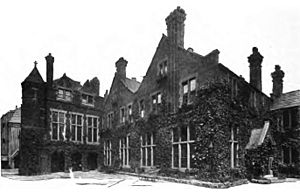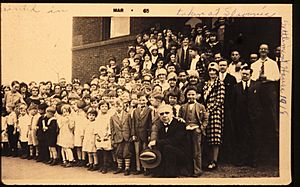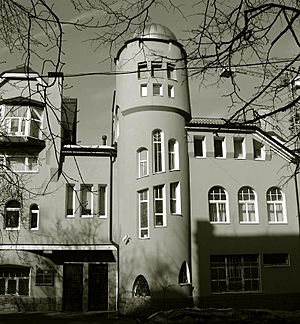Settlement movement facts for kids
The settlement movement was a social movement that started in the 1880s in England and the United States. It wanted to bring people from different parts of society, especially the rich and the poor, closer together. The main idea was to create "settlement houses" in poor city areas. In these houses, middle-class volunteers would live and work. They hoped to share knowledge and culture, and help their low-income neighbors.
Settlement houses offered many services. These included daycare for children, English classes for immigrants, and healthcare. The goal was to improve the lives of people living in poverty. One of the most famous settlement houses was Hull House, started by Jane Addams and Ellen Gates Starr.
Contents
History of Settlement Houses
How the Movement Began in England

The settlement movement began in 1884. This was when Toynbee Hall was founded in Whitechapel, London. These early houses were different from later ones in America. They often provided food, shelter, and education. Wealthy people and city residents gave money to support them. University scholars also volunteered their time to teach.
In Victorian England, people became more concerned about poverty. This led to the idea of university students living in poor areas. They would live and work alongside local people. Through their efforts, settlement houses were created. These places offered education, help with saving money, sports, and arts. Religious leaders often praised these efforts. However, some groups who wanted big social changes sometimes criticized them.
The movement believed that poverty was caused by big changes in society. For example, the growth of factories and cities. They thought private charities were the best way to push for social improvements. The movement focused on people working together as a group.
Today, the British Association of Settlements and Social Action Centres is a network of these kinds of organizations. There is also a global group called The International Federation of Settlements and Neighborhood Centers (IFS).
The movement led to many new social policies. It also created new ways to help people who were struggling. For example, the "Poor Man's Lawyer" service started when a lawyer offered free legal help. This encouraged others to do the same. Settlement houses were very important for the start of social work.
As more women could go to university, young female graduates joined the movement. The Women's University Settlement was founded in 1887. It was started by women from famous universities like Cambridge and Oxford.
Settlement Houses in Australia
Australia's first settlement work began with the University of Sydney Women's Society. Helen Phillips started this society in 1891. Before this, she visited universities in England. There, she learned about how they supported women students. She also learned about settlement work from her brother. He was involved with a college mission that helped poorer people.
Helen Phillips brought this idea back to Australia. She formed the Women's Society. This group visited patients in hospitals. They also set up night schools, especially for girls. After Phillips left, Louisa Macdonald continued the work. The Settlement gained support from other groups over time. It provided services for Aboriginal and migrant families. Today, it is known as The Settlement Neighbourhood Centre in Sydney.
The Movement in the United States
The settlement movement came to the United States through Jane Addams. She traveled to Europe and learned about the system in England. Addams became the main leader of the movement in the U.S. She had help from many others, including Mary Rozet Smith and Alice Hamilton.
The movement became very popular between 1890 and 1910. During this time, over 12 million people immigrated to the U.S. They came from countries like Ireland, Russia, and Italy. Many worked in factories for low wages. They often lived in crowded, unhealthy apartments. Children sometimes had to work to help their families. Jacob Riis wrote a book in 1890 called How the Other Half Lives. It showed people how immigrants lived in New York City.
The most famous settlement house in the U.S. is Chicago's Hull House. Jane Addams and Ellen Gates Starr founded it in 1889. Addams had visited Toynbee Hall in England before starting Hull House. Unlike some English houses, Hull House was not based on religion. Instead, Addams based it on democratic ideas. It focused on providing education and fun activities for immigrant women and children.
Many other important settlement houses were founded. These include Denison House in Boston (1892) and Henry Street Settlement in New York (1893). University Settlement House, founded in 1886, is the oldest in the U.S. These houses helped lead social changes. They also inspired "settlement schools" in rural areas like Appalachia.
By 1911, there were 413 settlement houses in 32 states. The number peaked at almost 500 by the 1920s. By 1993, the number had dropped to about 300.
American settlement houses used a philosophy called "scientific philanthropy." This meant that instead of just giving money, charities should give people tools and skills. This would help them break out of poverty. American charity workers worried that the strong social class system in Europe would develop in the U.S.
Settlement Houses in Russia
The movement also reached Russia. In 1905, Stanislav Shatsky and Alexander Zelenko set up a network of educational and social places in Moscow. They called it "Settlement." The government closed this network in 1908. They were accused of being involved in socialist activities.
What Settlement Houses Do Today
Today, settlement houses are still community-focused groups. They offer many services. These include early education, youth guidance, and programs for older people. They also have special programs for young people who are too old for foster care. Now, professional employees and students staff these places. They no longer require staff to live alongside the people they serve.
Impact of the Movement
Settlement houses had a big impact on how cities are planned and buildings are designed. For example, the master plan for Reston, Virginia, aimed to mix people from different economic backgrounds.
See also
 In Spanish: Movimiento settlement para niños
In Spanish: Movimiento settlement para niños



